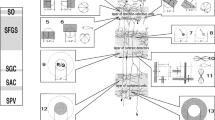Summary
The lateral optic nerve of Limulus polyphemus, the horseshoe crab, contains 4 types of axons, which originate from eccentric cells, retinula cells, rudimentary eye cells, and from unidentified cells in the brain that give rise to the efferent fibers. Though small in diameter in a young animal, the eccentric cell axons in the adult grow to the same size as the rudimentary eye axons, which are originally the largest fibers in the nerve of the small Limulus. Cytoplasmic content, particularly the orderly distribution of microtubules, is identical in the three types of visual fibers. The segregation of rudimentary eye axons into a separate grouping within the optic nerve in small animals gives way to a homogeneous distribution in the adult. Interrupting the optic nerve leads to a proximal pile-up of secretory granules in a few fibers. The identity of these granules with those in the synaptoid terminations of photoreceptors establishes these fibers as efferent. The same operation leads to a conspicuous hypertrophy of subsurface cisternae within retinula cell axons.
Similar content being viewed by others
References
Boulton, P. S.: Degeneration and regeneration in the insect central nervous system. I. Z. Zellforsch. 101, 98–118 (1969).
—, Rowell, C. H. F.: Degeneration and regeneration in the insect central nervous system. II. Zellforsch. 101, 119–134 (1969).
Clark, A. W., Millecchia, R., Mauro, A.: The ventral photoreceptor cells of Limulus. I. The microanatomy. J. gen. Physiol. 54, 289–309 (1969).
Dumont, J. N., Anderson, E., Chomyn, E.: The anatomy of the peripheral nerve and its ensheating artery in the horseshoe crab, Xiphosura (Limulus) polyphemus. J. Ultrastruct. Res. 13, 38–64 (1965).
Fahrenbach, W. H.: The morphology of the eyes of Limulus. II. Ommatidia of the compound eye. Z. Zellforsch. 93, 451–483 (1969).
—: The morphology of the Limulus visual system. III. The lateral rudimentary eye. Z. Zellforsch. 105, 303–316 (1970a).
- Evidence for neurosecretion in Limulus polyphemus. (Abstr.) J. Cell Biol. 47, 59a (1970b).
Hartline, H. K., Wagner, H. G., MacNichol, E. F.: The peripheral origin of nervous activity in the visual system. Cold Spr. Harb. Symp. quant. Biol. 17, 125–141 (1952).
Millecchia, R., Bradbury, J., Mauro, A.: Simple photoreceptors of Limulus polyphemus. Science 154, 1199–1201 (1966).
Nolte, J., Brown, J. E., Smith, T. G.: A hyperpolarizing component of the receptor potential in the median ocellus of Limulus. Science 162, 677–679 (1968).
Nunnemacher, R. F., Davis, P. O.: The fine structure of the Limulus optic nerve. J. Morph. 125, 61–70 (1968).
Pannesi, P. A.: Anatomical studies on the optic nerve of Limulus polyphemus. Thesis, Clark University, Worcester, Massachusetts (1964).
Passano, L. M.: Neurosecretory control of molting in crabs by the X-organ sinus gland complex. Physiol. comp. 3, 155–189 (1953).
Rosenbluth, J.: Subsurface cisternae and their relationship to the neuronal plasma membrane. J. Cell Biol. 13, 405–421 (1921).
Scharrer, B.: Neurosecretion. XIV. Ultrastructural study of sites of release of neurosecretory material in blattarian insects. Z. Zellforsch. 89, 1–16 (1968).
—, Kater, S. B.: Neurosecretion. XV. An electron microscopic study of the corpora cardiaca of Periplaneta americana after experimentally induced hormone release. Z. Zellforsch. 95, 177–186 (1969).
Shuster, C. N.: On morphometric and serological relationships within the Limulidae, with particular reference to Limulus polyphemus (L.). Thesis, New York University, New York (1955).
Sotelo, C., Palay, S. L.: The fine structure of the lateral vestibular nucleus in the rat. I. Neurons and neuroglial cells. J. Cell Biol. 36, 151–179 (1968).
Waterman, T. H., Enami, M.: Neurosecretion in the lateral rudimentary eye of Tachypleus, a xiphosuran. Pubbl. Staz. zool. Napoli 24 (Suppl.), 81–82 (1954).
—, Wiersma, C. A. G.: The functional relation between retinal cells and optic nerve in Limulus. J. exp. Zool. 126, 59–85 (1954).
Author information
Authors and Affiliations
Additional information
This study constitutes Publication No. 483 from the Oregon Regional Primate Research Center, supported by Grants FR00163 and EY 00392 from the National Institutes of Health and by a Bob Hope Grant-in-Aid by Fight-for-Sight, Inc., New York City.
The author wishes to thank Mrs. Audrey Griffin for patient and excellent technical assistance.
Rights and permissions
About this article
Cite this article
Fahrenbach, W.H. The morphology of the Limulus visual system. Z. Zellforsch. 114, 532–545 (1971). https://doi.org/10.1007/BF00325638
Received:
Issue Date:
DOI: https://doi.org/10.1007/BF00325638




